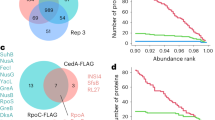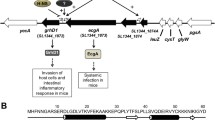Abstract
The DNA sequence of the gyr genes from Salmonella enterica serovar Typhimurium revealed strong similarity between gyrB and its counterpart in Escherichia coli. However, the gyrA gene showed similarity to the E. coli homologue only downstream from the Pribnow box of the promoter, with the sequence upstream diverging markedly. Since this region encompasses the binding sites for the Fis DNA binding protein in E. coli, we investigated the possibility that the gyrA genes in the two species might differ in their responses to this regulatory protein. Fis was found to act as a transcriptional repressor of both gyr genes in S. enterica. In electrophoretic mobility shift assays, Fis was found to bind to both the gyrA and gyrB promoters of S. enterica, despite the strong divergence from the E. coli sequence on the part of the former. The binding sites were mapped by DNase I protection assays, and the results are consistent with conservation of the mechanism of Fis-mediated repression between the two bacterial species.






Similar content being viewed by others
References
Ali Azam T, Iwata A, Nishimura A, Ueda S, Ishihama A (1999) Growth phase-dependent variation in protein composition of the Escherichia coli nucleoid. J Bacteriol 181:6361–6370
Appleman JA, Ross W, Salomon J, Gourse RL (1998) Activation of Escherichia coli rRNA transcription by FIS during a growth cycle. J Bacteriol 180:1525–1532
Blattner FR, et al (1997) The complete genome sequence of Escherichia coli K-12. Science 277:1453–1474
Drlica K (1992) Control of bacterial DNA supercoiling. Mol Microbiol 6:425–433.
Farinha MA, Kropinski AM (1990) Construction of broad-host range plasmid vectors for easy visible selection and analysis of promoters. J. Bacteriol 172:3496–3499
Filutowicz M, Ross W, Wild J, Gourse RL (1992) Involvement of Fis protein in replication of the Escherichia coli chromosome. J Bacteriol 174:398–407
Finkel SE, Johnson RC (1992) The Fis protein: it's not just for DNA inversion any more. Mol Microbiol 6:3257–3265
Gille H, Egan JB, Roth A, Messer W (1991) The Fis protein binds and bends the origin of chromosomal DNA replication, oriC, of Escherichia coli. Nucleic Acids Res 19:4167–4172
Johnson RC, Ball CA, Pfeffer D, Simon MI (1988) Isolation of the gene encoding the Hin recombinational enhancer binding protein. Proc Natl Acad Sci USA 85:3484–3488
Koch C, Kahmann R (1986) Purification and properties of the Escherichia coli host factor required for inversion of the G segment in bacteriophage Mu. J Biol Chem 261:15673–15678
Marshall DG, Bowe F, Hale C, Dougan G, Dorman CJ (2000) DNA topology and adaptation of Salmonella typhimurium to an intracellular environment. Philos Trans R Soc Lond B Biol Sci 355:565–574.
McClelland M, et al (2001) Complete genome sequence of Salmonella enterica serovar Typhimurium LT2. Nature 413:852–856
Menzel R, Gellert M (1987) Modulation of transcription by DNA supercoiling: a deletion analysis of the Escherichia coli gyrA and gyrB promoters. Proc Natl Acad Sci USA 84:4185–4189
Miller JH (1992) A short course in bacterial genetics. Cold Spring Harbor Laboratory Press, Cold Spring Harbor, N.Y.
Muskhelishvili G, Travers A (2003) Transcription factor as a topological homeostat. Front Biosci 8:D279–285
Ninnemann O, Koch C, Kahmann R (1992) The E. coli fis promoter is subject to stringent control and autoregulation. EMBO J 11:1075–1083
Pemberton IK, Muskhelishvili G, Travers AA, Buckle M (2002) FIS modulates the kinetics of successive interactions of RNA polymerase with the core and upstream regions of the tyrT promoter. J Mol Biol 318:651–663
Schneider R, Travers A, Muskhelishvili G (1997) FIS modulates growth phase-dependent topological transitions of DNA in Escherichia coli. Mol Microbiol 26:519–530
Schneider R, Travers A, Kutateladze T, Muskhelishvili G (1999) A DNA architectural protein couples cellular physiology and DNA topology in Escherichia coli. Mol Microbiol 34:953–964
Schneider R, Travers A, Muskhelishvili G (2000) The expression of the Escherichia coli fis gene is strongly dependent on the superhelical density of DNA. Mol Microbiol 38:167–175
Sternberg NL, Maurer R (1991) Bacteriophage-mediated generalized transduction in Escherichia coli and Salmonella typhimurium. Methods Enzymol 204:18–43
Straney R, Krah R, Menzel R (1994) Mutations in the −10 TATAAT sequence of the gyrA promoter affect both promoter strength and sensitivity to DNA supercoiling. J Bacteriol 176:5999–6006
Studier FW, Moffatt BA (1986) Use of bacteriophage T7 RNA polymerase to direct selective high level expression of cloned genes. J Mol Biol 189:113–130
Walker KA, Atkins CL, Osuna R (1999) Functional determinants of the Escherichia coli fis promoter: roles of –35, −10, and transcription initiation regions in the response to stringent control and growth phase-dependent regulation. J Bacteriol 181:1269–1280
Wilson RL, Libby SJ, Freet AM, Boddicker JD, Fahlen TF, Jones BD (2001) Fis, a DNA nucleoid-associated protein, is involved in Salmonella typhimurium SPI-1 invasion gene expression. Mol Microbiol 39:79–88
Acknowledgements
We thank Dr K. T. Hughes for the fis::cat strain TH2285, Arlene Kelly for performing the fis complementation experiment, and the Health Research Board of Ireland and Science Foundation Ireland for financial support. The research described in this paper was performed in compliance with current laws governing genetic experimentation in the Republic of Ireland
Author information
Authors and Affiliations
Corresponding author
Additional information
Communicated by W. Goebel
An erratum to this article is available at http://dx.doi.org/10.1007/s00438-003-0916-1.
Rights and permissions
About this article
Cite this article
Keane, O.M., Dorman, C.J. The gyr genes of Salmonella enterica serovar Typhimurium are repressed by the factor for inversion stimulation, Fis. Mol Gen Genomics 270, 56–65 (2003). https://doi.org/10.1007/s00438-003-0896-1
Received:
Accepted:
Published:
Issue Date:
DOI: https://doi.org/10.1007/s00438-003-0896-1




